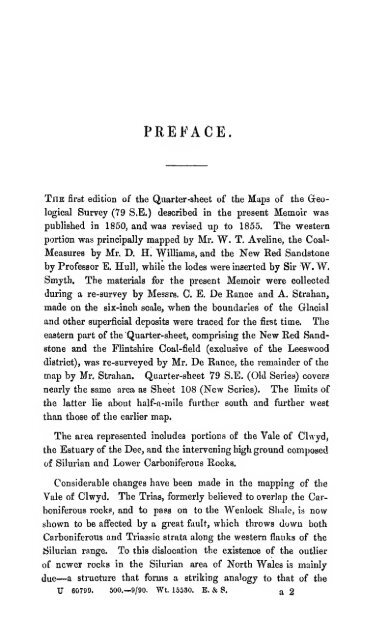The geology of the neighbourhoods of Flint, Mold, and Ruthin ...
The geology of the neighbourhoods of Flint, Mold, and Ruthin ...
The geology of the neighbourhoods of Flint, Mold, and Ruthin ...
Create successful ePaper yourself
Turn your PDF publications into a flip-book with our unique Google optimized e-Paper software.
PREFACE.<br />
TnE first edition <strong>of</strong> <strong>the</strong> Quarter-sheet <strong>of</strong> <strong>the</strong> Maps <strong>of</strong> <strong>the</strong> Geo-<br />
logical Survey (79 S.E.) described in <strong>the</strong> present Memoir was<br />
published in 1850, <strong>and</strong> was revised up to 1855. <strong>The</strong> western<br />
portion was principally mapped by Mr. W. T. Aveline, <strong>the</strong> Coal-<br />
Measures by Mr. D. H. Williams, <strong>and</strong> <strong>the</strong> New Red S<strong>and</strong>stone<br />
by Pr<strong>of</strong>essor E. Hull, while <strong>the</strong> lodes were inserted by Sir W. W.<br />
Smyth. <strong>The</strong> materials for <strong>the</strong> present Memoir were collected<br />
during a re-survey by Messrs. 0. E. De Ranee <strong>and</strong> A. Strahan,<br />
made on <strong>the</strong> six-inch scale, when <strong>the</strong> boundaries <strong>of</strong> <strong>the</strong> Glacial<br />
<strong>and</strong> o<strong>the</strong>r superficial deposits were traced for <strong>the</strong> first time. <strong>The</strong><br />
eastern part <strong>of</strong> <strong>the</strong> Quarter-sheet, comprising <strong>the</strong> New Red S<strong>and</strong>-<br />
stone <strong>and</strong> <strong>the</strong> <strong>Flint</strong>shire Coal-field (exclusive <strong>of</strong> <strong>the</strong> Leeswood<br />
district), was re-surveyed by Mr. De Ranee, <strong>the</strong> remainder <strong>of</strong> <strong>the</strong><br />
map by Mr. Strahan. Quarter-sheet 79 S.E. (Old Series) covers<br />
nearly <strong>the</strong> same area as Sheet 108 (New Series). <strong>The</strong> limits <strong>of</strong><br />
<strong>the</strong> latter lie about half-a-mile fur<strong>the</strong>r south <strong>and</strong> fur<strong>the</strong>r west<br />
than those <strong>of</strong> <strong>the</strong> earlier map.<br />
<strong>The</strong> area represented includes portions <strong>of</strong> <strong>the</strong> Vale <strong>of</strong> Clwyd,<br />
<strong>the</strong> Estuary <strong>of</strong> <strong>the</strong> Dee, <strong>and</strong> <strong>the</strong> intervening high ground composed<br />
<strong>of</strong> Silurian <strong>and</strong> Lower Carboniferous Rocks.<br />
Considerable changes have been made in <strong>the</strong> mapping <strong>of</strong> <strong>the</strong><br />
Vale <strong>of</strong> Clwyd. <strong>The</strong> Trias, formerly believed to overlap <strong>the</strong> Car-<br />
boniferous rocks, <strong>and</strong> to pass on to <strong>the</strong> Wenlock Shale, is now<br />
shown to be affected by a great fault, which throws down both<br />
Carboniferous <strong>and</strong> Triassic strata along <strong>the</strong> western flanks <strong>of</strong> <strong>the</strong><br />
Silurian range. To this dislocation <strong>the</strong> existence <strong>of</strong> <strong>the</strong> outlier<br />
<strong>of</strong> newer rocks in <strong>the</strong> Silurian area <strong>of</strong> North Wales is mainly<br />
due—a structure that forms a striking analogy to that <strong>of</strong> <strong>the</strong><br />
U 60799. 500.—9/90. Wt. 15530. B. & S. a 2



